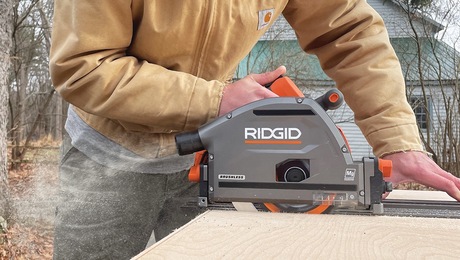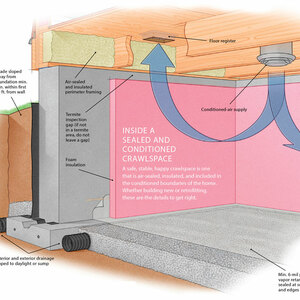Thanks to everyone with all of the advice on setting roof trusses in a previous post. Trusses are up and braced- sheathing this weekend. The trusses withstood 40-50 mph gusts this past week, I was more than a little nervous.
My new problem: I ordered 5/12 trusses to mount over the 8×20 mudroom/laundry room addition. The pitch matches perfectly with the pitch of the existing roof. Problem is, the new truss sits about 1 1/2″ HIGHER than the existing trusses. My mistake, I should have considered it before ordering the trusses.
So now I have a problem to deal with. I can either lower the existing top plate by the 1 and 1/2 inches needed to accomodate or I can raise the plane of the existing roof. For a variety of reasons, I like the idea of raising the existing roof plane. It will involve fixing some fascia and overhangs, but those considerations appear pretty minor.
My question is what would be the best way to raise the roof plane? Sleepers on top of the existing roof re-sheathed with new OSB seems like the obvious answer but I worry about creating a moisture trap. I have read about a product similar to a SIP where OSB and foam are laminated that I could put right over the existing sheating. But I fear this would trap moisture also. At this point, I am considering removing the existing sheating (area is ~ 26 x 13) and building up the level I need with purlins and then re-sheathing and replacing roof. The entire house is getting an entire re-roof and re-side as part of this process anyway, so it’s not too much additional work.
I also thought about raising the new trusses a few inches and breaking the plane completely. But for aesthetic reasons, I would rather match the planes so they are continuous across the seam of the existing house and the addition. I also worry that by only separating the planes by a few inches, I may be creating problems with snow melt, etc, as this detail may be a little tough to prevent water infiltration.
So I throw this out to the creative thinkers of breaktime. Any ideas?


















Replies
Seems as though you have thought many of the angles to this through. I really think your first thought of lowering the new section 1 1/2 " is the best solution.
In choice one I assume you will have to lower the trusses section by cutting the wall studs down one by one and renailing them to the floor plate? This would make your ceiling a little lower than you would like?
In scenario 2 going over top with insulation would put insulation in a place it does you no good unless you have a cathedral ceiling. If your attic ceiling is insulated that is where you want to add insulation not the roof. If your attic is vented the new insulation would be useless and not cost effective. Your right about the osb/insulation product though its best used for cathedral ceilings where it would add to the insulation r- total.
In scenario 3 sleepers and new osb is a good option but requires you to purchase new sheathing and refit fascia/rakes. If you don't have good attic vents now would be a good time to address the issue with venting above the fascia with the gap you create.
Scenario 4 is I think the better option than three because you don't have to purchase new sheathing provided you save and reuse what you have. It allows you to raise the level of the rafters and create more room for insulation above the walls in the attic where your baffles are installed. It comes down to time or money! If you have the extra time to remove and replace the sheathing you can save the cost on sheathing. If you can make more money elsewhere and have limited time then sleepers over top is the choice.
I still like Scenario 1 the best as it is the most cost effective solution if you can live with the 1 1/2 " less ceiling.
Don't feel bad - Matching up trusses to existing roofs is a HUGE pain. I'd say it works out right about half the time.
A few things come to mind that have worked for me in the past.
First is to slide the trusses over on the walls a bit. Every 1 1/4" you can slide them will gain you 1/2" in height. Obviously this will change your overhang lengths and fascia heights, so it may not work well.
Notching the 2nd top plate sometimes works. But that also obviously weakens it a bit, and may not be a good idea depending on the truss span and loading.
If the trusses are fairly small, you can probably rip the top chords down a bit. Obviously you'll have to talk to the truss company first and get a repair drawing from them.
Depending on where the plate is on the heel of the truss, you may be able to notch the bottom chord over the bearing a bit. (Again, after consulting the truss manufacturer) That changes your ceiling height a bit, so that may be a problem.
A combination of some of the above ideas might do the trick if one of them won't quite do the job.
when i'm trying to match trusses to an existing roof.. we figure it as close as possible before we order the trusses
then .. we don't build the walls until we have the trusses on hand...that way we can change the wall height to whatever we need
this works fine for most additions.. but not so good with new construction... but then with new construction, there is no problem anyways
If you have a double top plate AND the studs in the wall align with the truss layout , then I would remove the top-top plate from under the trusses.. Use metal plate connectors and drop your trusses.
Second option for me would be to strap the tops of the EXISTING roofs trusses or rafters with 2x material and lay sheathing over the entire roof area of both the addition and the existing . That would bring everything into alingment at both the eaves and the ridge, Need to box the soffit to hide the different depth of rafters though.
Ridge vent and cut opening thru the existing roof to allow for venting.
Thanks for the responses everyone. Currently have a call in to inspector to see if notching the top of the two top plates is an option (in his eyes). This will fit with BH and Dovetails suggestions. Walls are framed with 2x6 and are 8' long with a window in the middle. There is a lot of meat supporting those top plates. 20' span overall so I am hoping the inspector will OK this process. Dove- what's your take on the necessity of removing the shething for the second method you mention? My real concern with that method is trapping moisture and creating a problem for myself long term. The soffit and rake fix won't be a problem. I've got enough room to rework those so everything will still line up.
FWIW I am now leaning toward solution #2
My take is that if you cut holes thru the existing roof, say 8" sq. top and bottom of each existing rafter bay then you shouldn't have a problem. Just make sure you are venting both areas , the old one under the existing roof and the new one created by the overlay.
I would strip off any old roofing material though. I hate trying to track leaks thru old roofing. The more I think about this solution the more I actually prefer it. It leaves you the double plate, allows you to lay sheathing across the seam between the roofs which will help blend the roofs. Both of which are advantageous in my opinion.
dovetails second is a good one. it is commonly done to create a cold roof system and will not trap moisture. Go right over the old sheathing first with tarpaper,then strapping sized right and follow up with new sheathing on all. edited to add :
you could even add a ply of insulatrion board - given an ich and half needed shim up, you could use 3/4" EPS and 3/4" strapping screwed through it.
Welcome to the
Taunton University of Knowledge FHB Campus at Breaktime.
where ...
Excellence is its own reward!
Edited 3/10/2007 3:39 am ET by Piffin